Control Systems: Feedback Analysis and Design - Assignment
VerifiedAdded on 2023/03/30
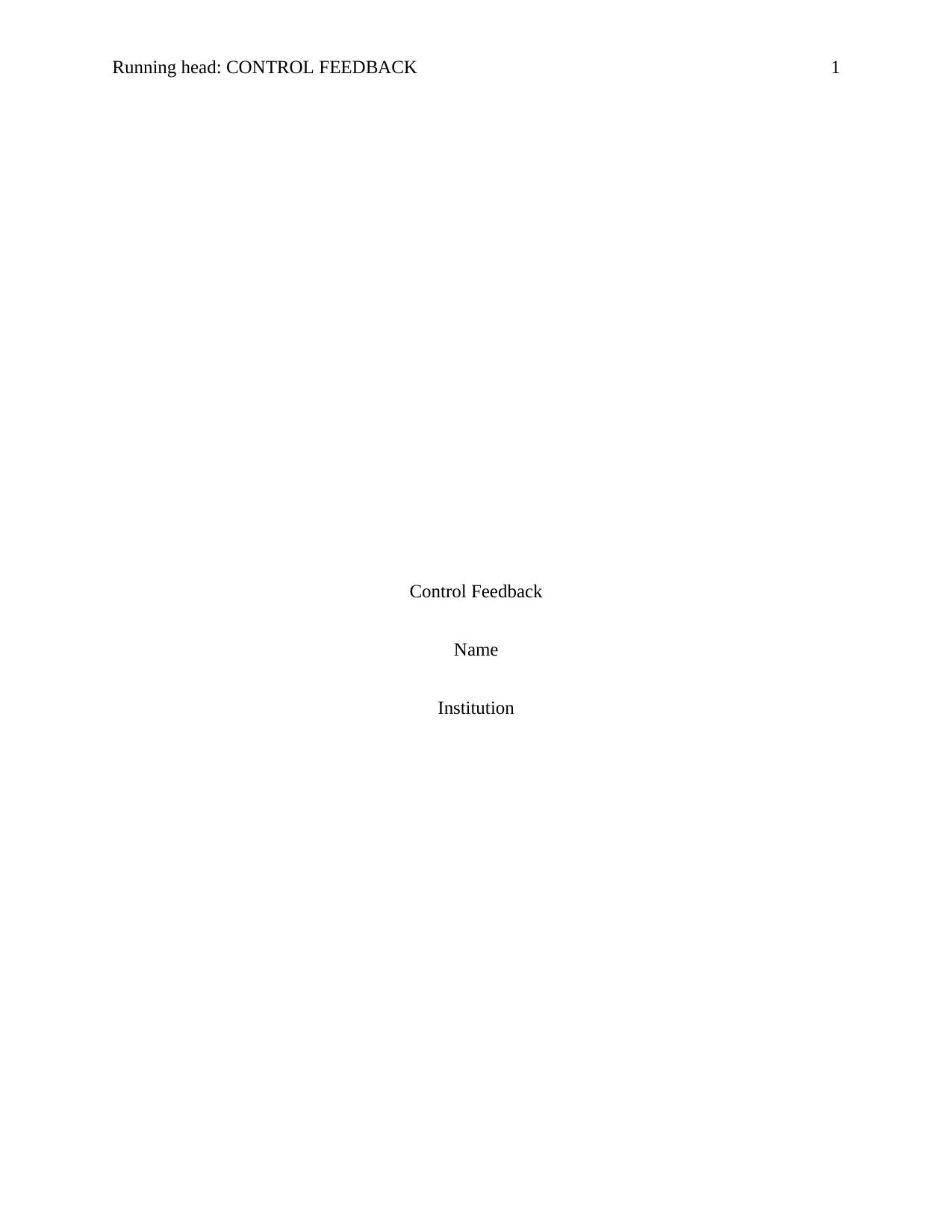
Control Feedback
Name
Institution
Paraphrase This Document
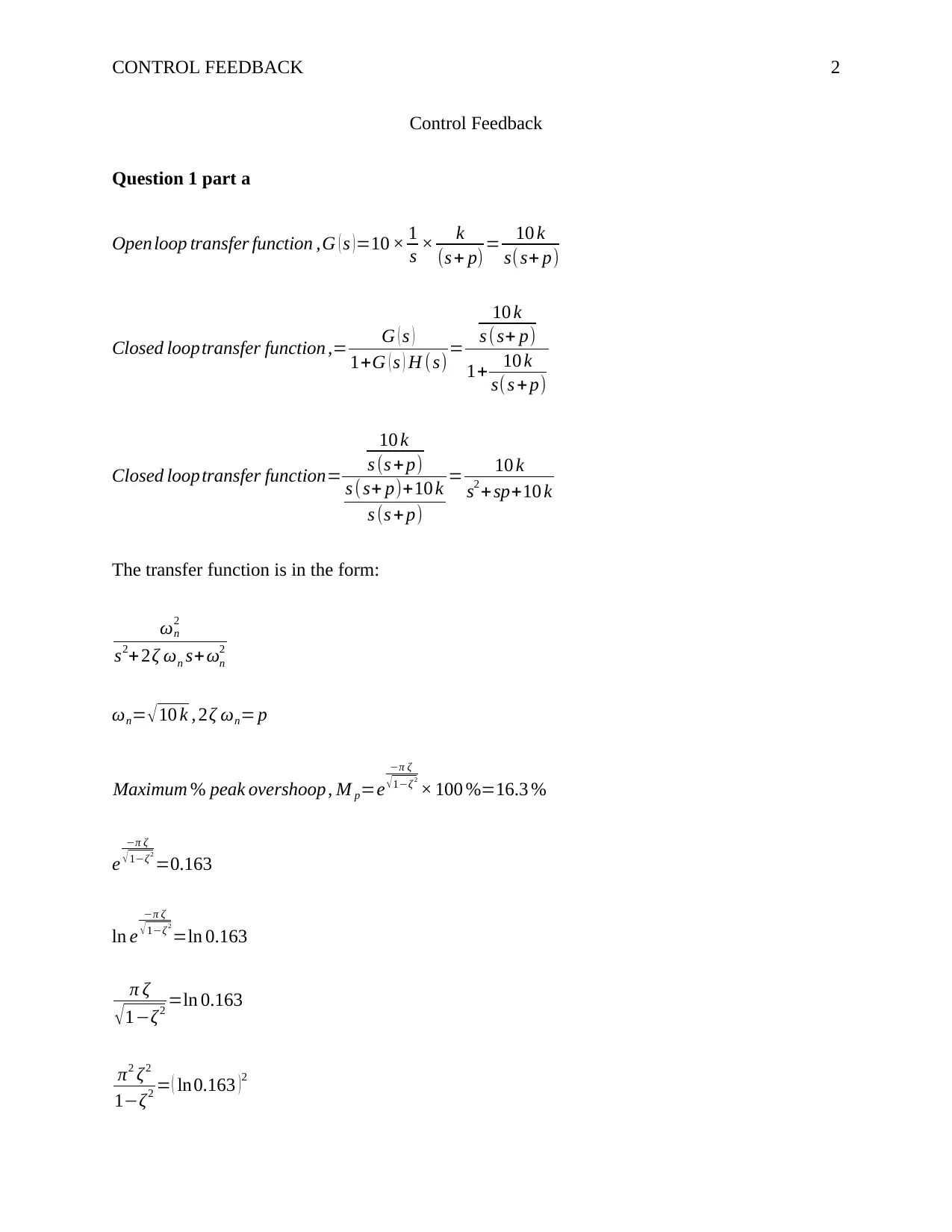
Control Feedback
Question 1 part a
Openloop transfer function ,G ( s )=10 × 1
s × k
(s + p) = 10 k
s( s+ p)
Closed looptransfer function ,= G ( s )
1+G ( s ) H (s)=
10 k
s ( s+ p)
1+ 10 k
s(s + p)
Closed looptransfer function=
10 k
s (s + p)
s (s+ p)+10 k
s (s + p)
= 10 k
s2 +sp+10 k
The transfer function is in the form:
ωn
2
s2+ 2ζ ωn s+ωn
2
ωn= √ 10 k , 2ζ ωn= p
Maximum % peak overshoop , M p=e
−π ζ
√1−ζ 2
× 100 %=16.3 %
e
−π ζ
√ 1−ζ 2
=0.163
ln e
−π ζ
√ 1−ζ 2
=ln 0.163
π ζ
√ 1−ζ2 =ln 0.163
π2 ζ2
1−ζ2 = ( ln0.163 )2

π2 ζ2= ( ln0.163 )2 − ( ln 0.1632 ) 2 ζ 2
π2 ζ2+ ( ln 0.163 ) 2 ζ 2= ( ln 0.163 )2
ζ 2 ( π2 + ( ln 0.163 )2 )= ( ln 0.163 )2
ζ = √ ( ln 0.163 )2
π2 + ( ln 0.163 )2 =0.5
settling time, T s= 4
ζ ωn
=0.8 seconds
4
0.5 ωn
=0.8
ωn= 4
0.5 ×0.8 =10
ωn= √ 10 k
p=2ζ ωn=2 ×0.5 ×10=10
ωn= √ 10 k=10
10 k =102=100
k =100
10 =10
Therefore , k= p=10
Question 1 part b
⊘ This is a preview!⊘
Do you want full access?
Subscribe today to unlock all pages.

Trusted by 1+ million students worldwide
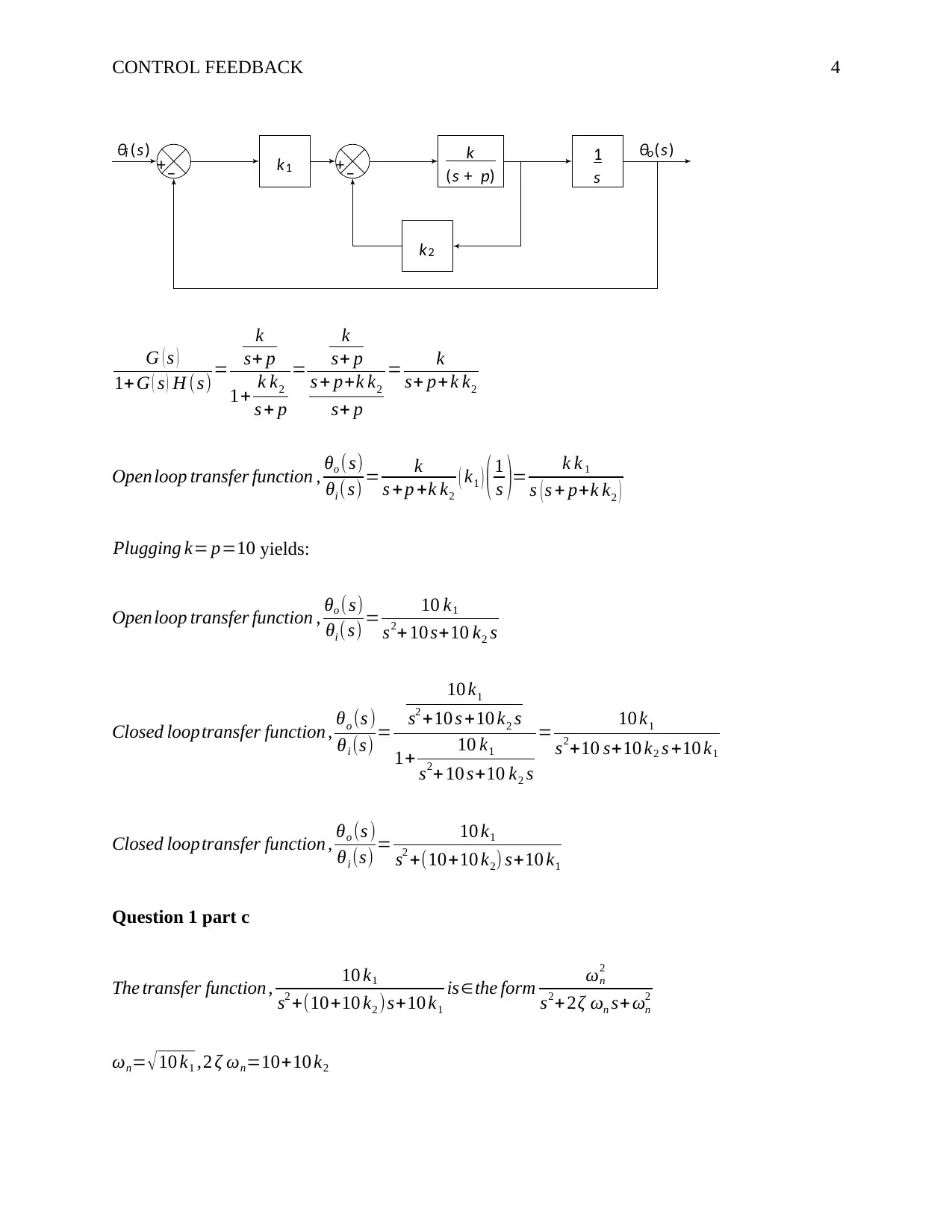
G ( s )
1+ G ( s ) H (s) =
k
s+ p
1+ k k2
s + p
=
k
s+ p
s + p+k k2
s+ p
= k
s+ p+k k2
Openloop transfer function , θo (s)
θi ( s) = k
s +p +k k2
( k1 ) ( 1
s )= k k 1
s ( s + p+k k2 )
Plugging k= p=10 yields:
Openloop transfer function , θo (s)
θi ( s) = 10 k1
s2+ 10 s+10 k2 s
Closed looptransfer function , θo (s )
θi (s) =
10 k1
s2 +10 s +10 k2 s
1+ 10 k1
s2+ 10 s+10 k2 s
= 10 k1
s2+10 s+10 k2 s +10 k1
Closed looptransfer function , θo (s )
θi (s) = 10 k1
s2 +(10+10 k2) s+10 k1
Question 1 part c
The transfer function , 10 k1
s2 +(10+10 k2 )s+10 k1
is∈the form ωn
2
s2+ 2ζ ωn s+ ωn
2
ωn= √10 k1 ,2 ζ ωn=10+10 k2
−
+
θi (s) k1 −
+ k
(s + p)
k2
1
s
θo(s)
Paraphrase This Document
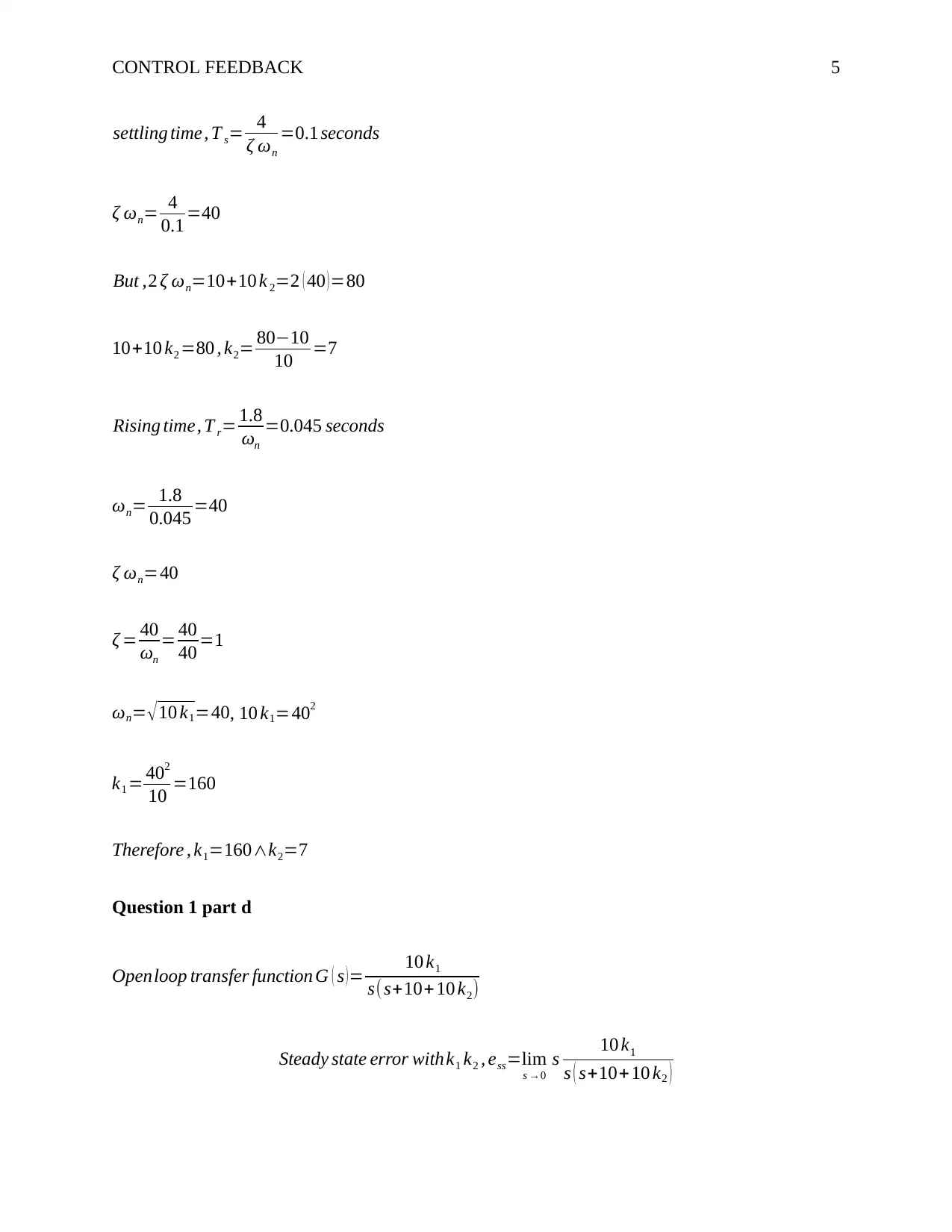
settling time, T s= 4
ζ ωn
=0.1 seconds
ζ ωn= 4
0.1 =40
But ,2 ζ ωn=10+10 k 2=2 ( 40 )=80
10+10 k2 =80 , k2= 80−10
10 =7
Rising time, T r= 1.8
ωn
=0.045 seconds
ωn= 1.8
0.045 =40
ζ ωn=40
ζ = 40
ωn
= 40
40 =1
ωn= √10 k1=40, 10 k1=402
k1 = 402
10 =160
Therefore , k1=160∧k2=7
Question 1 part d
Openloop transfer function G ( s ) = 10 k1
s(s+10+ 10 k2)
Steady state error withk1 k2 , ess=lim
s →0
s 10 k1
s ( s+10+10 k2 )

¿ lim
s → 0
s 1600
s ( s+10+ 400)= 1600
410 =3.9024
Since this is a type 1 system, there will be steady state error to ramp inputs only. Hence, the
steady state error to unit step inputs is zero. The performance with k1 ∧k2 to get a steady state
error of 3.9024 is unachievable in a practical system.
Question 2 part a
0.2 d2 θo
d t2 +2 d θo
dt =V i
Apply Laplace transform on both sides to get:
(0.2 s2 +2 s)θo (s)=V i (s)
G ( s ) = θo ( s )
V i (s )= 1
0.2 s2 +2 s =
1
0.2
0.2 s2+2 s
0.2
= 5
s2 +10 s
G ( s )= 5
s2 +10 s
Question 2 part b
H ( s )=3.2 , G ( s )= 5
s2+10 s
−
+ G (s)
3.2
θi (s) θo(s)
⊘ This is a preview!⊘
Do you want full access?
Subscribe today to unlock all pages.

Trusted by 1+ million students worldwide

G(s)cl = G ( s )
1+G ( s ) H (s)=
5
s2 +10 s
1+ 5
s2+10 s × 3.2
G(s)cl =
5
s2+10 s
s2 +10 s+ 16
s2+10 s
= 5
s2 +10 s +16
G(s)cl = θo ( s )
V i (s)= 5
s2+10 s+16
Question 2 part c
G(s)cl = θo ( s )
V i (s)= 5
s2+10 s+16
θo ( s ) = 5 V i (s)
s2 +10 s+16
V i ( s )= 48
s
θo ( s ) =
5 ( 48
s )
s2 +10 s+16 = 240
s ( s2 +10 s +16) = 240
s (s2+ 8 s +2 s+16)= 240
s(s+2)(s+8)
240
s (s +2)(s +8) = A
s + B
s +2 + C
s+8
240=A ( s+2)(s +8)+ Bs(s+8)+Cs( s+2)
When s=0
240=A ( 2 ) ( 8 )+ 0+0 ¿
Paraphrase This Document
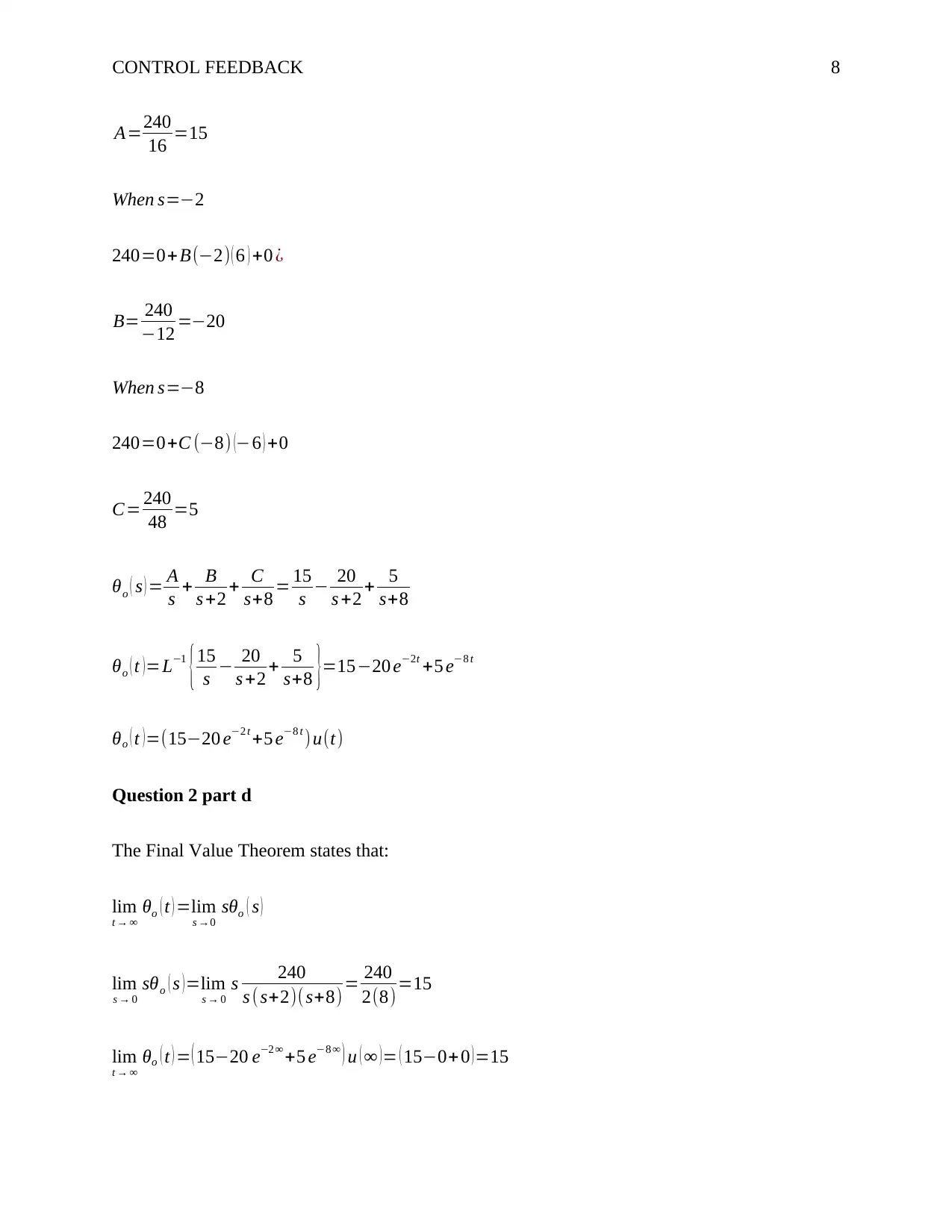
A=240
16 =15
When s=−2
240=0+ B(−2) ( 6 ) +0 ¿
B= 240
−12 =−20
When s=−8
240=0+C (−8) (−6 ) +0
C= 240
48 =5
θo ( s ) = A
s + B
s +2 + C
s+8 = 15
s − 20
s +2 + 5
s+8
θo ( t )=L−1
{15
s − 20
s +2 + 5
s+8 }=15−20 e−2t +5 e−8 t
θo ( t ) =(15−20 e−2 t +5 e−8 t )u(t)
Question 2 part d
The Final Value Theorem states that:
lim
t → ∞
θo ( t ) =lim
s →0
sθo ( s )
lim
s → 0
sθo ( s ) =lim
s → 0
s 240
s (s+2)( s+8)= 240
2(8)=15
lim
t → ∞
θo ( t ) = ( 15−20 e−2 ∞ +5 e−8 ∞ ) u ( ∞ )= ( 15−0+0 )=15
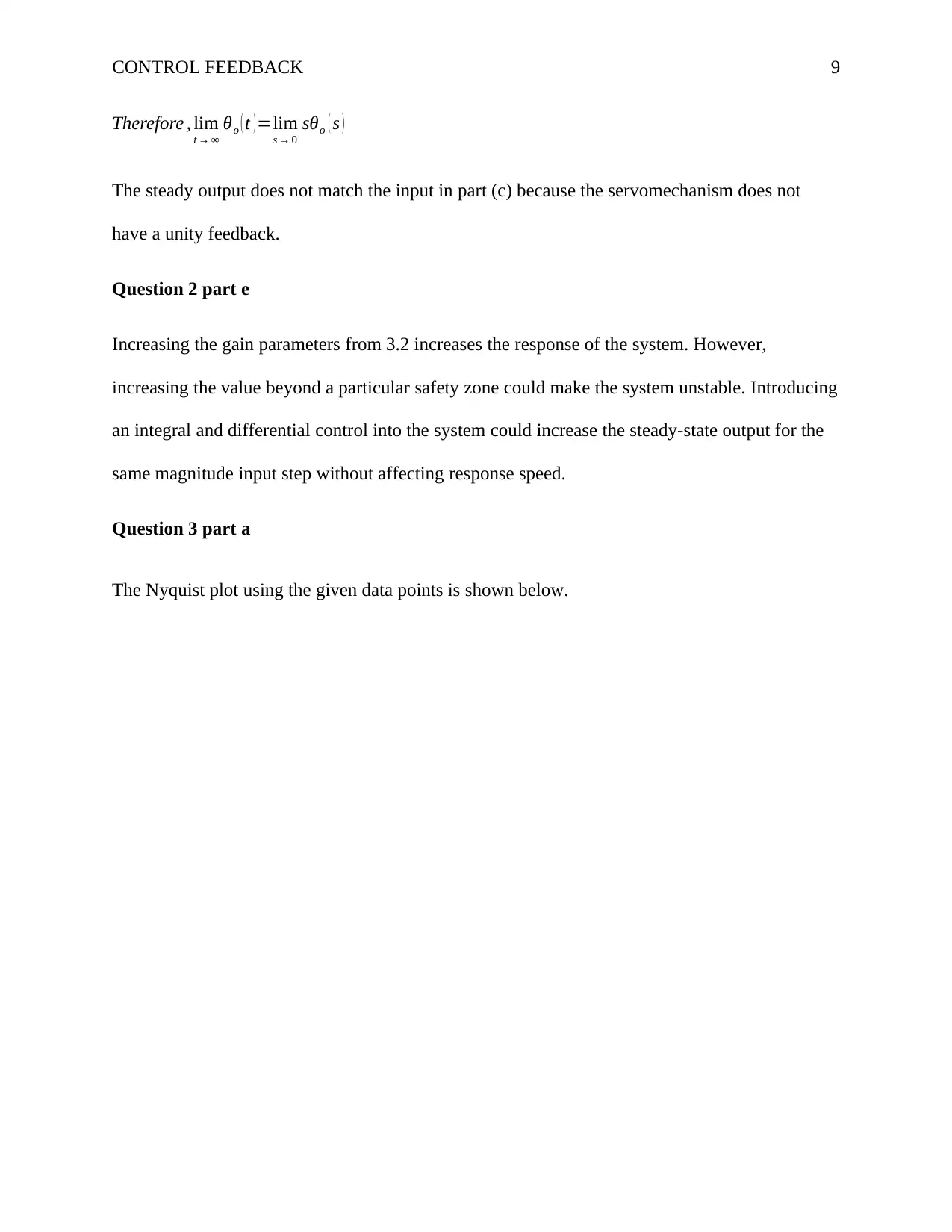
Therefore , lim
t → ∞
θo ( t )=lim
s → 0
sθo ( s )
The steady output does not match the input in part (c) because the servomechanism does not
have a unity feedback.
Question 2 part e
Increasing the gain parameters from 3.2 increases the response of the system. However,
increasing the value beyond a particular safety zone could make the system unstable. Introducing
an integral and differential control into the system could increase the steady-state output for the
same magnitude input step without affecting response speed.
Question 3 part a
The Nyquist plot using the given data points is shown below.
⊘ This is a preview!⊘
Do you want full access?
Subscribe today to unlock all pages.

Trusted by 1+ million students worldwide
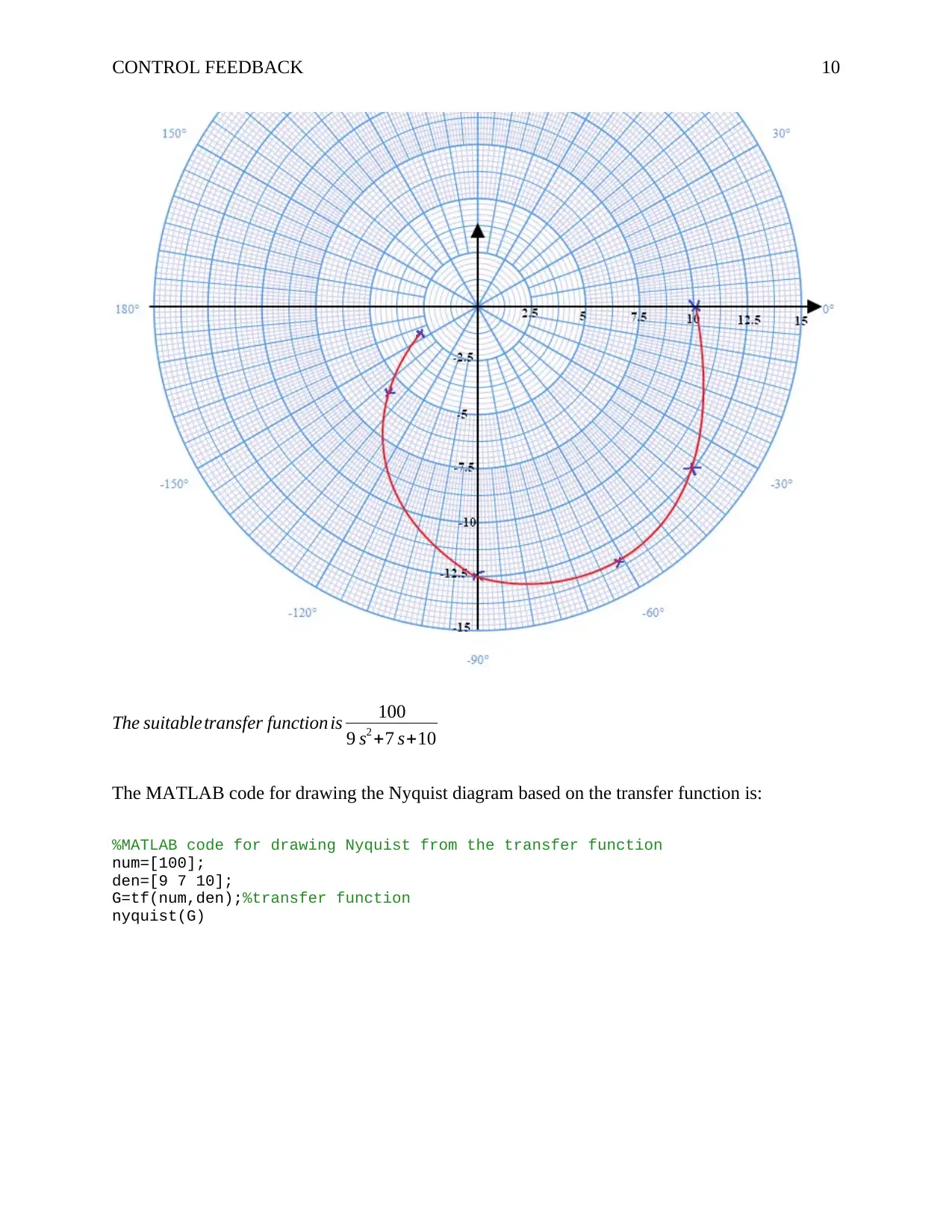
The suitabletransfer function is 100
9 s2 +7 s+10
The MATLAB code for drawing the Nyquist diagram based on the transfer function is:
%MATLAB code for drawing Nyquist from the transfer function
num=[100];
den=[9 7 10];
G=tf(num,den);%transfer function
nyquist(G)
Paraphrase This Document

Question 3 part b
Transfer function= 100
−9 ω2 + j 7 ω +10 = 100
( 10−9 ω2 ) + j 7 ω
The magnitude=20 log 100
√ ( 10−9 ω2 )2
+49 ω2
dB
The phase of the system=−tan−1
( 7 ω
10−9 ω2 )
%MATLAB code for calculating magnitude and phase
omega=1.2
mag=20*log10(100/(sqrt((10-9*omega^2)^2+49*omega^2)))
Phase_a=-atan(7*omega/(10-9*omega^2));
Phase=Phase_a*180/pi
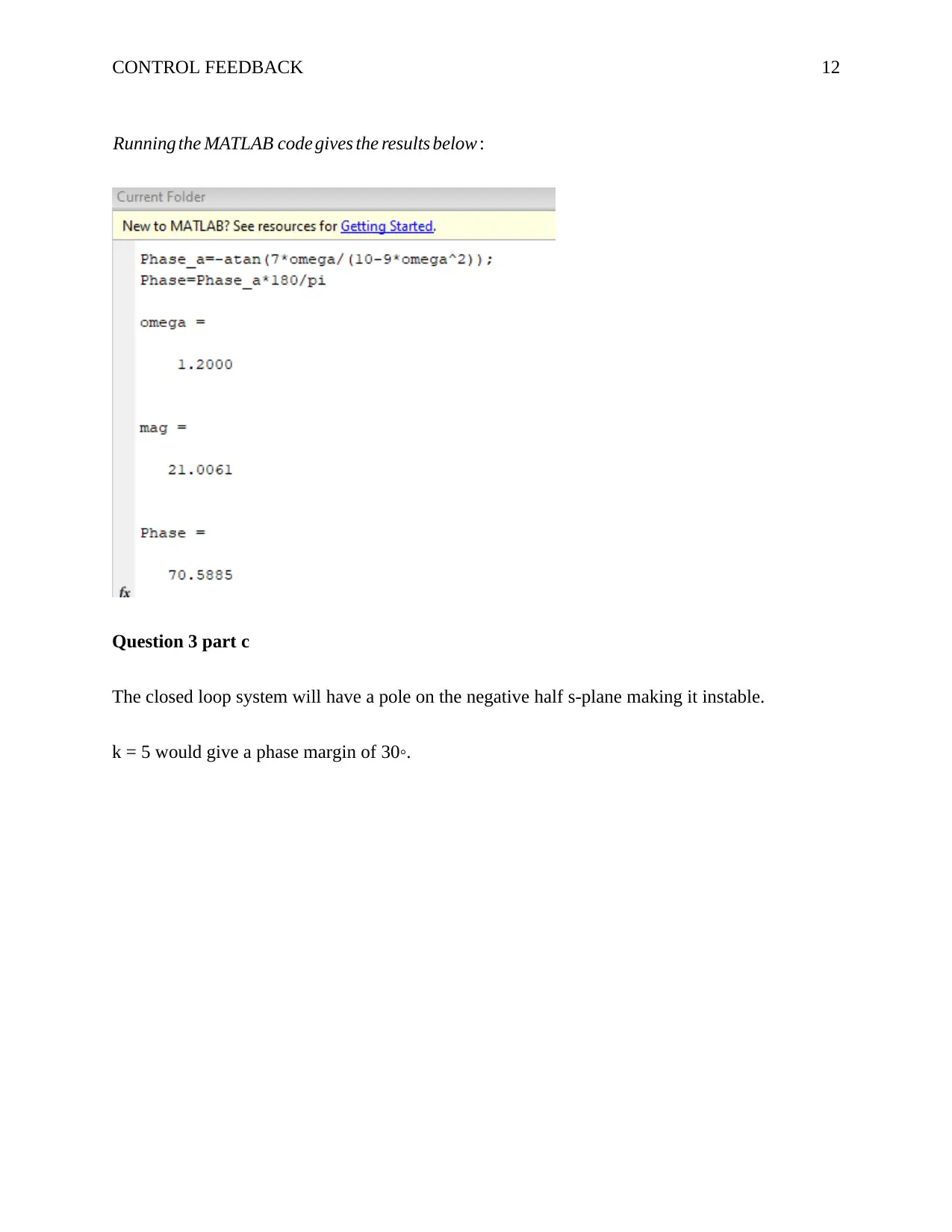
Running the MATLAB code gives the results below :
Question 3 part c
The closed loop system will have a pole on the negative half s-plane making it instable.
k = 5 would give a phase margin of 30◦.
⊘ This is a preview!⊘
Do you want full access?
Subscribe today to unlock all pages.

Trusted by 1+ million students worldwide
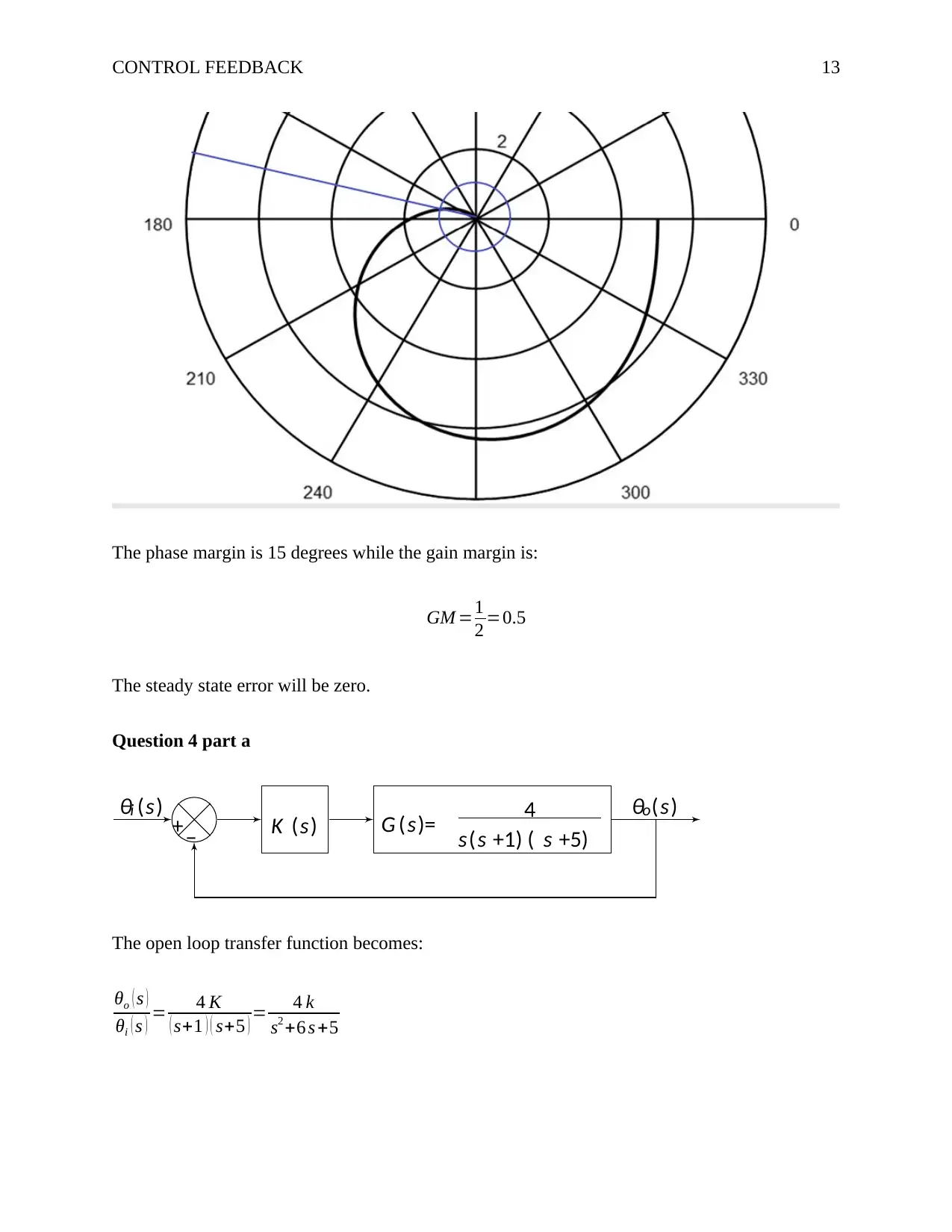
The phase margin is 15 degrees while the gain margin is:
GM =1
2 =0.5
The steady state error will be zero.
Question 4 part a
The open loop transfer function becomes:
θo ( s )
θi ( s ) = 4 K
( s+1 ) ( s+5 ) = 4 k
s2 +6 s +5
−
+
θi (s) K (s) G (s)= 4
s(s +1) ( s +5)
θo(s)
Paraphrase This Document
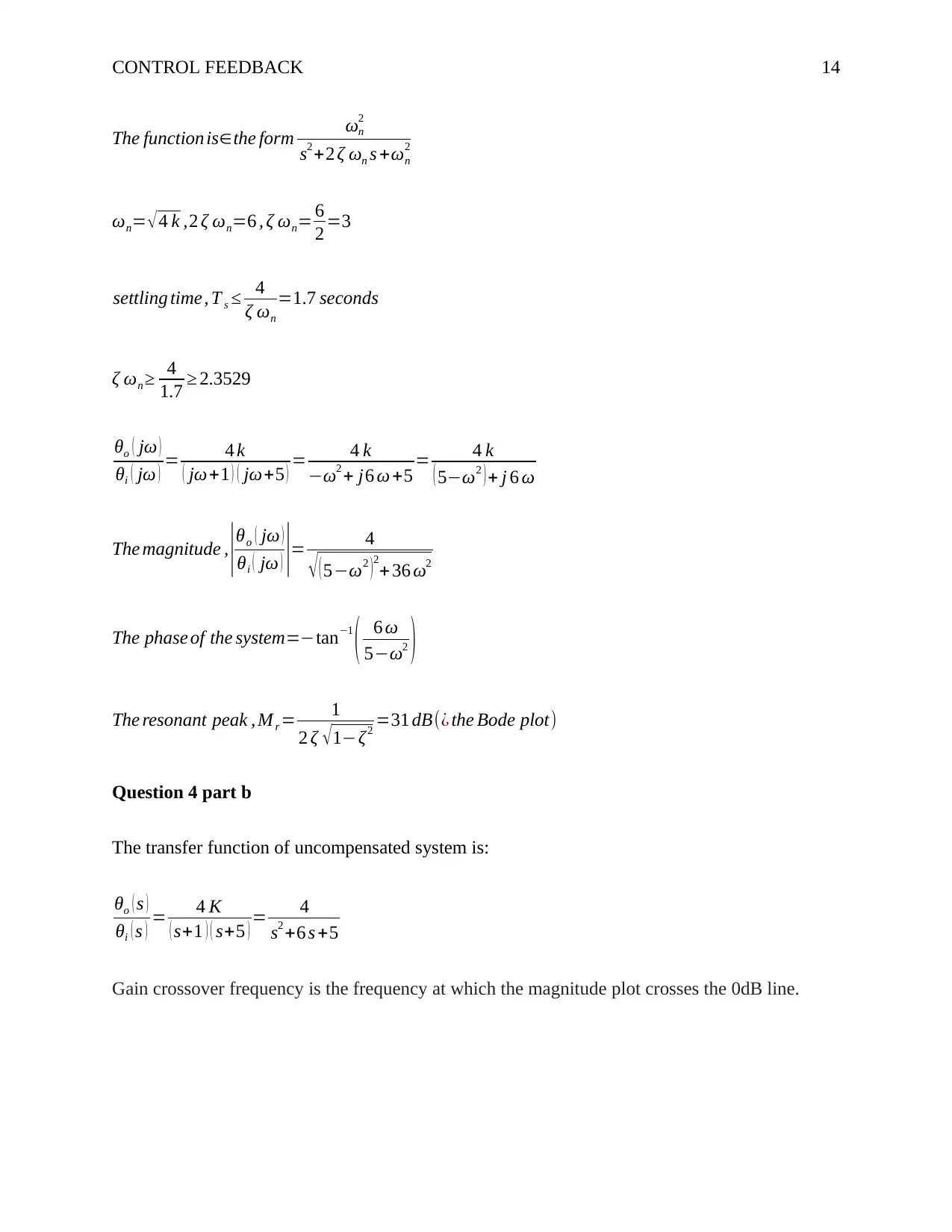
The function is∈the form ωn
2
s2 +2 ζ ωn s +ωn
2
ωn= √4 k ,2 ζ ωn=6 , ζ ωn= 6
2 =3
settling time, T s ≤ 4
ζ ωn
=1.7 seconds
ζ ωn ≥ 4
1.7 ≥ 2.3529
θo ( jω )
θi ( jω ) = 4 k
( jω+1 ) ( jω+5 ) = 4 k
−ω2 + j6 ω +5 = 4 k
( 5−ω2 ) + j 6 ω
The magnitude ,
|θo ( jω )
θi ( jω ) |= 4
√ ( 5−ω2 ) 2
+ 36 ω2
The phase of the system=−tan−1
( 6 ω
5−ω2 )
The resonant peak , M r = 1
2 ζ √1−ζ2 =31 dB(¿ the Bode plot)
Question 4 part b
The transfer function of uncompensated system is:
θo ( s )
θi ( s ) = 4 K
( s+1 ) ( s+5 ) = 4
s2 +6 s +5
Gain crossover frequency is the frequency at which the magnitude plot crosses the 0dB line.
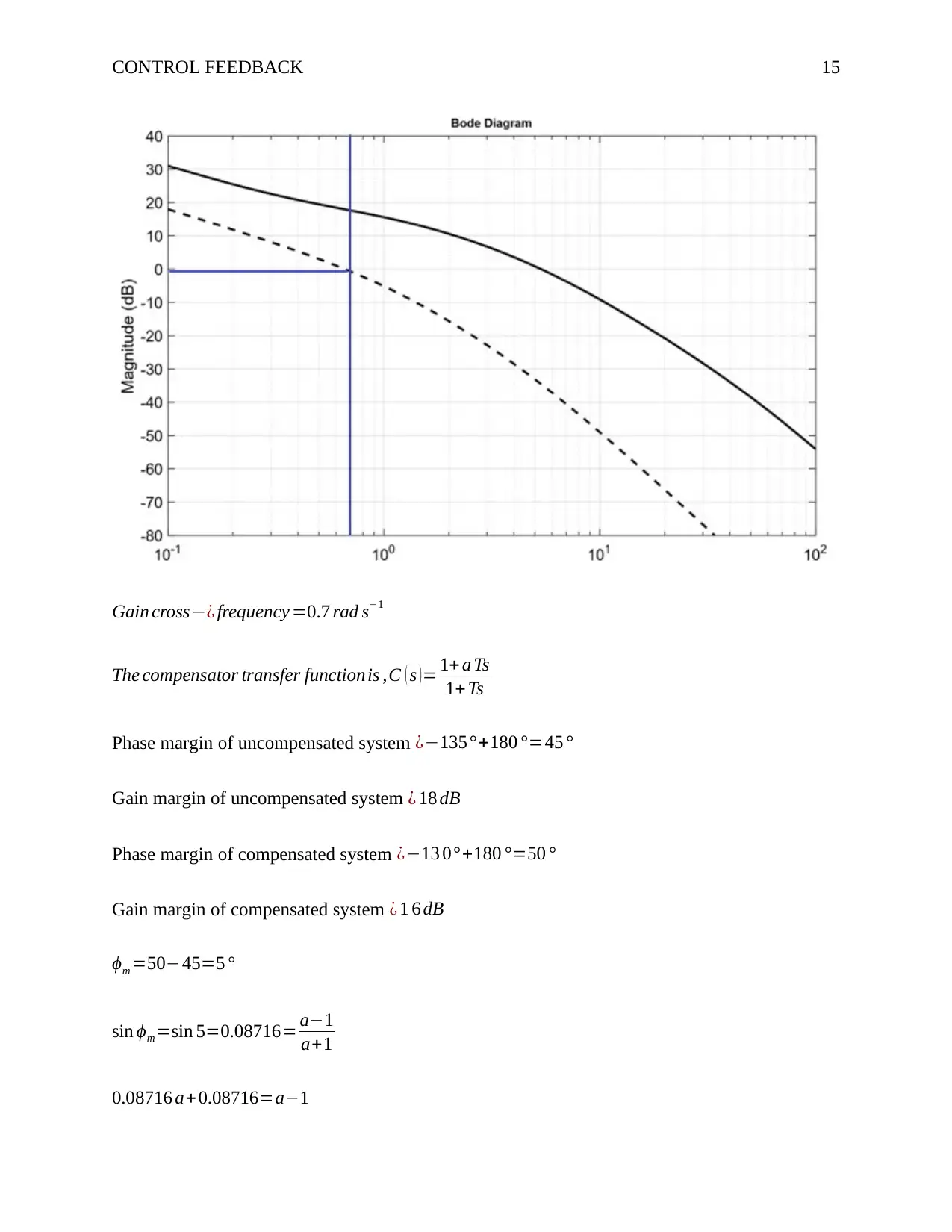
Gain cross−¿ frequency =0.7 rad s−1
The compensator transfer function is ,C ( s )= 1+ a Ts
1+ Ts
Phase margin of uncompensated system ¿−135° +180 °=45 °
Gain margin of uncompensated system ¿ 18 dB
Phase margin of compensated system ¿−13 0° +180 °=50 °
Gain margin of compensated system ¿ 1 6 dB
ϕm =50−45=5 °
sin ϕm =sin 5=0.08716= a−1
a+1
0.08716 a+0.08716=a−1
⊘ This is a preview!⊘
Do you want full access?
Subscribe today to unlock all pages.

Trusted by 1+ million students worldwide

a=1.191
ωm=−10 loga=−10 log 1.191=−0.759
Compensator pole , p=ωm √a=−0.759 √ 1.191=−0.828
Compensator zero , z=− p
a = 0.828
1.191 =0.695
Compensator transfer function= s−0.695
s +0.828
¿
1
−0.695 (1−0.695 s)
1
0.828 (1+ 828 s)
=−1.191 1−0.695 s
1+ 0.828 s
Compensator transfer function=−1.191 1−0.695 s
1+0.828 s
Question 4 part c
The MATLAB code is shown below:
%MATLAB code showing the gain and phase margin of compensated system
num=[4]
den=[1 6 5]
G=tf(num,den);%transfer function uncompensated system
numc=-1.191*[-0.695 1];
denc=[0.828 1];
Gc=tf(numc,denc);%transfer function compensated system
L=series(G,Gc);
bode(L)
grid
[Gm,Pm,wpm,wgm]=margin(L);
GmdB=20*log10(Gm);
[Gm,Pm,wpm,wgm]
The resulting output is:
Paraphrase This Document
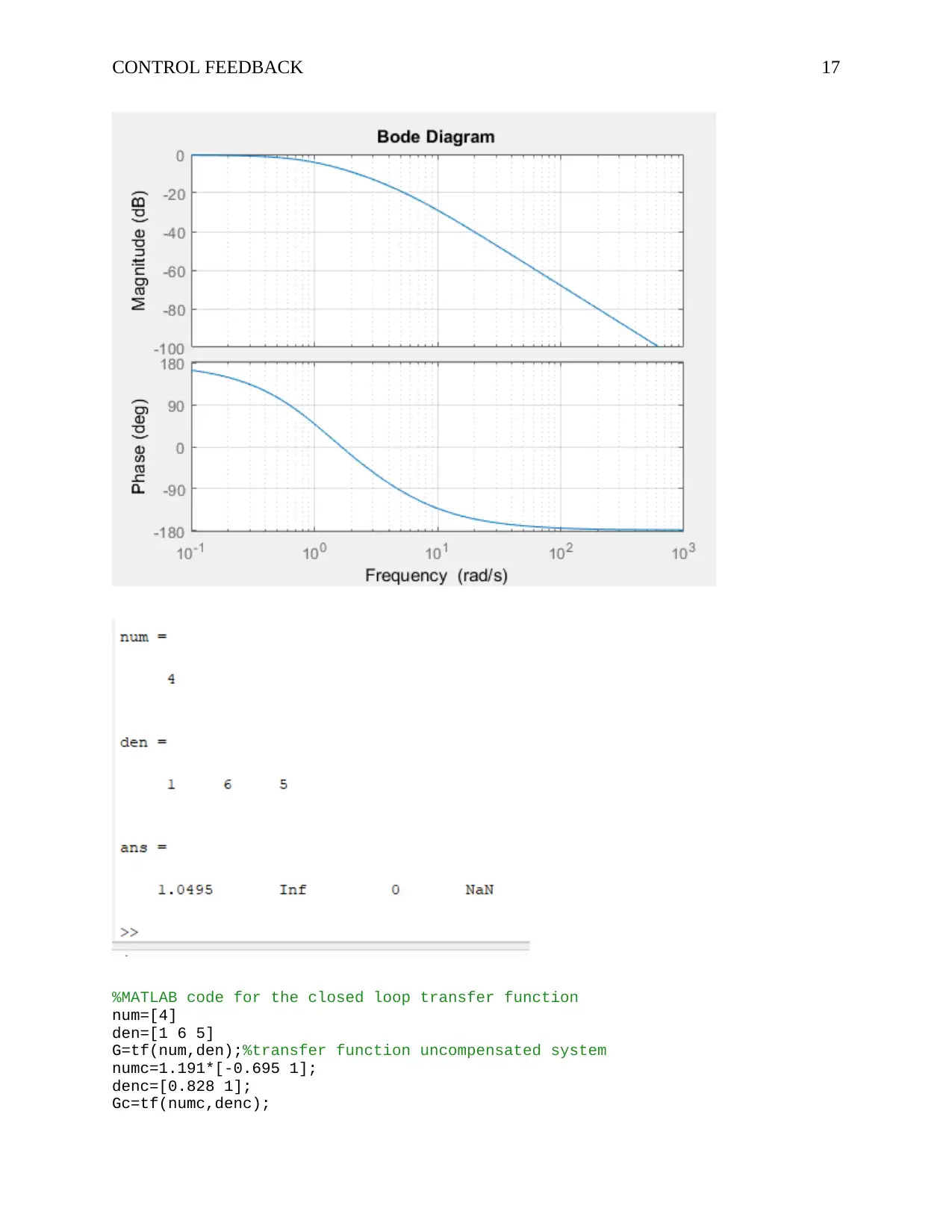
%MATLAB code for the closed loop transfer function
num=[4]
den=[1 6 5]
G=tf(num,den);%transfer function uncompensated system
numc=1.191*[-0.695 1];
denc=[0.828 1];
Gc=tf(numc,denc);
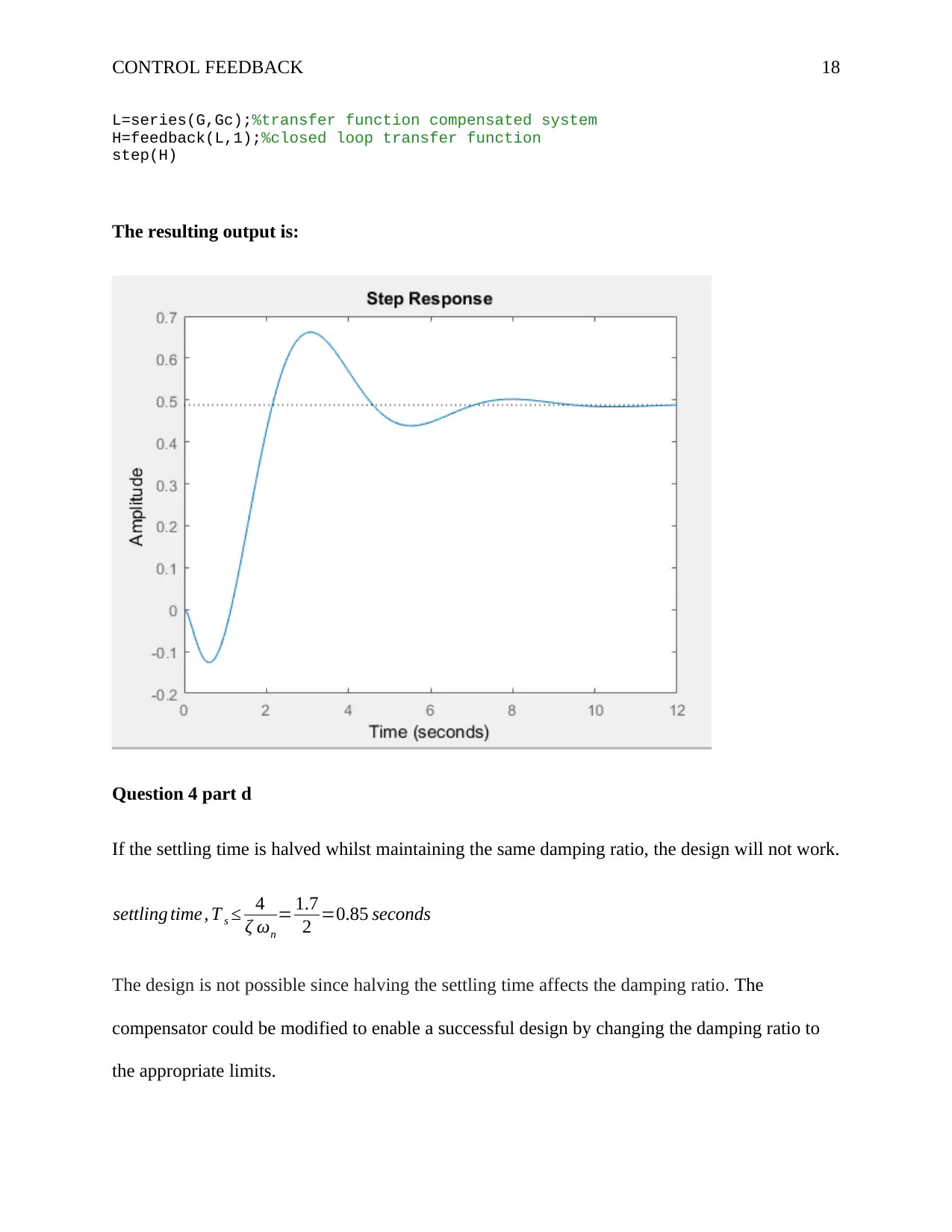
L=series(G,Gc);%transfer function compensated system
H=feedback(L,1);%closed loop transfer function
step(H)
The resulting output is:
Question 4 part d
If the settling time is halved whilst maintaining the same damping ratio, the design will not work.
settling time, T s ≤ 4
ζ ωn
= 1.7
2 =0.85 seconds
The design is not possible since halving the settling time affects the damping ratio. The
compensator could be modified to enable a successful design by changing the damping ratio to
the appropriate limits.
⊘ This is a preview!⊘
Do you want full access?
Subscribe today to unlock all pages.

Trusted by 1+ million students worldwide
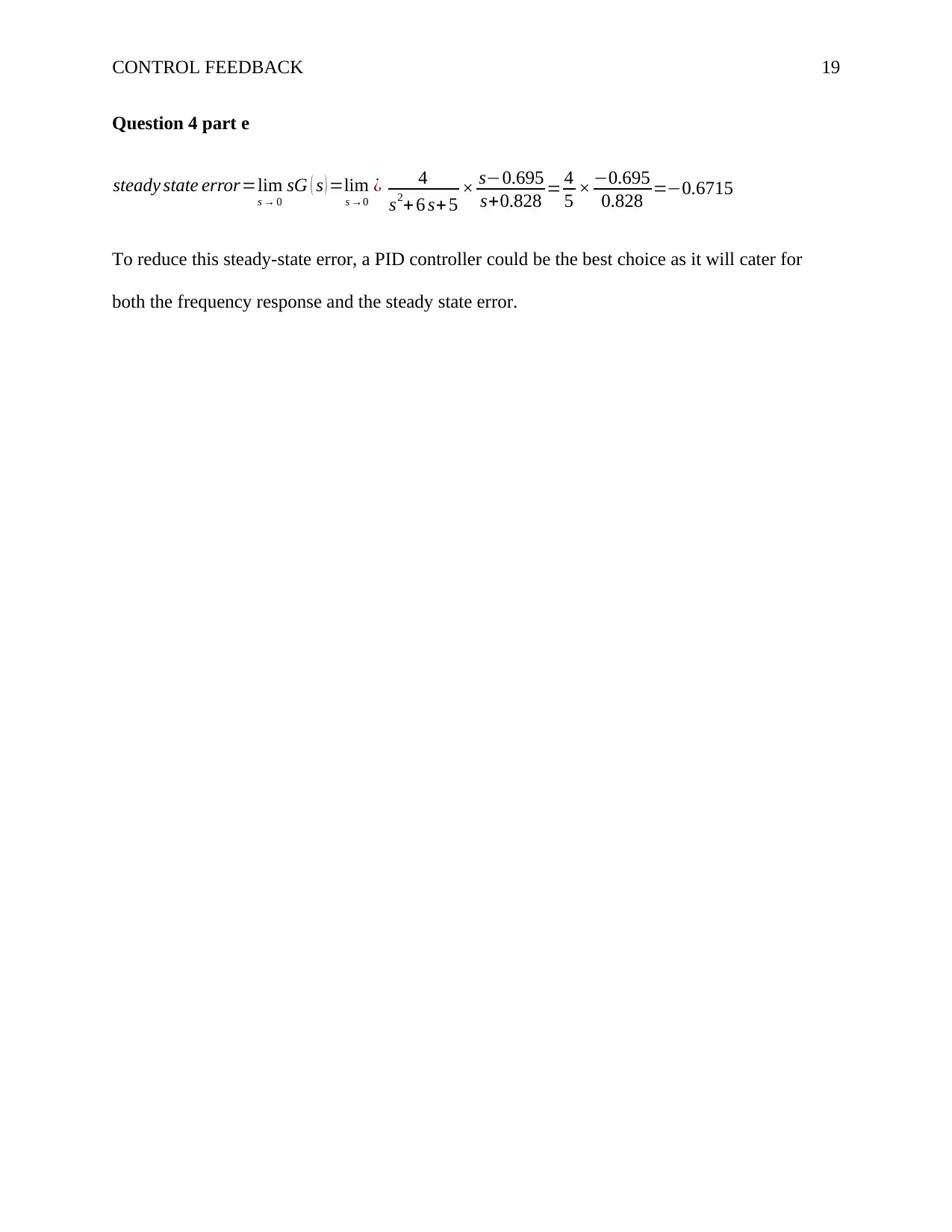
Question 4 part e
steady state error=lim
s → 0
sG ( s ) =lim
s →0
¿ 4
s2+ 6 s+ 5 × s−0.695
s+0.828 = 4
5 × −0.695
0.828 =−0.6715
To reduce this steady-state error, a PID controller could be the best choice as it will cater for
both the frequency response and the steady state error.
Related Documents
Your All-in-One AI-Powered Toolkit for Academic Success.
+13062052269
info@desklib.com
Available 24*7 on WhatsApp / Email
![[object Object]](/_next/static/media/star-bottom.7253800d.svg)
© 2024 | Zucol Services PVT LTD | All rights reserved.





